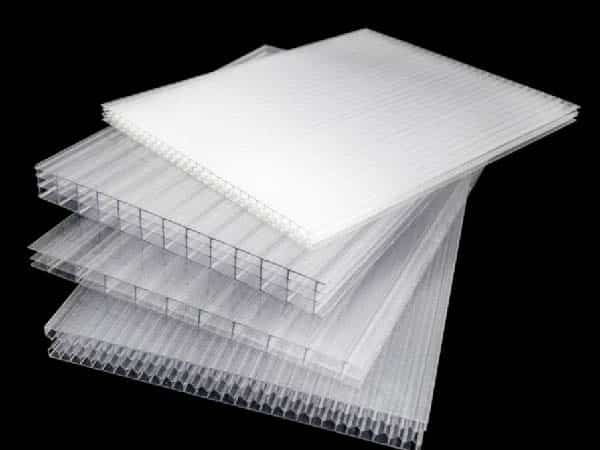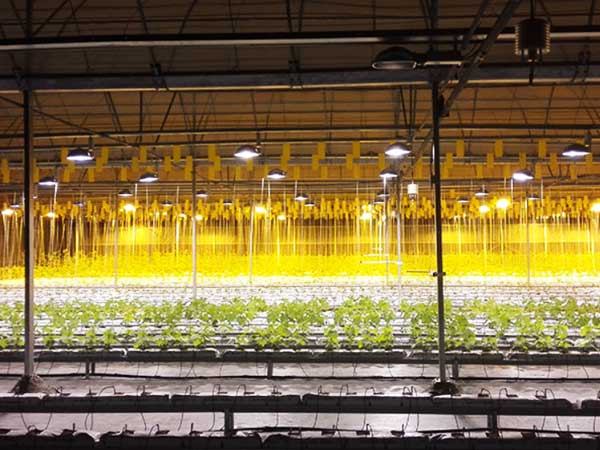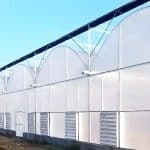In modern greenhouse farming, hydroponic systems are gradually replacing some traditional soil-based cultivation methods. These systems help increase crop yields, save water, and reduce pests and diseases. Compared to conventional planting, hydroponics allows for high-density cultivation and precise nutrient control, accelerating plant growth and improving quality.
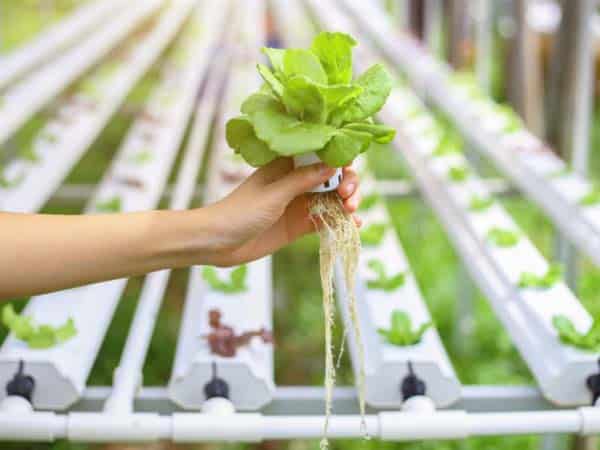
However, choosing the right hydroponic system for your greenhouse can be challenging. With so many options available, how do you know which one is best for your needs? Don’t worry! INSONGREEN’s greenhouse design experts have prepared this guide to explore the most common greenhouse hydroponic systems, comparing their advantages, disadvantages, and suitable crops. This article will help you select the best system based on your growing goals and greenhouse conditions.
7 Types of Greenhouse Hydroponic Systems
Hydroponic systems can be categorized into two main types based on how plant roots interact with the nutrient solution: Strict Hydroponics and Substrate-Based Hydroponics. Next, we will analyze the features, advantages, and ideal applications of each system, helping you choose the best hydroponic solution.
A. Strict Hydroponics Systems
In these systems, plant roots directly interact with nutrient solutions or mist without relying on solid growing media.
1. Deep Water Culture (DWC)
Deep Water Culture (DWC) is one of the most common and simplest hydroponic systems. It consists of a nutrient reservoir where plants are suspended above the water using net pots and growing media. The roots remain submerged in the nutrient solution, ensuring efficient nutrient absorption.
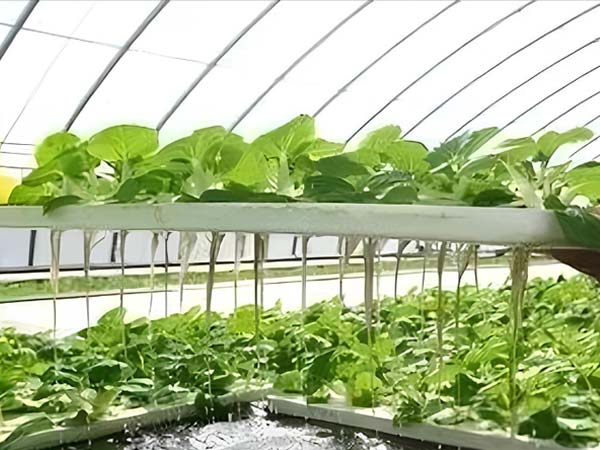
The key difference between DWC and NFT is the depth of the nutrient solution. DWC systems have deeper nutrient reservoirs and typically include a growing tank, planting board, nutrient reservoir, and circulation system, ensuring that plant roots remain submerged in nutrient-rich water.
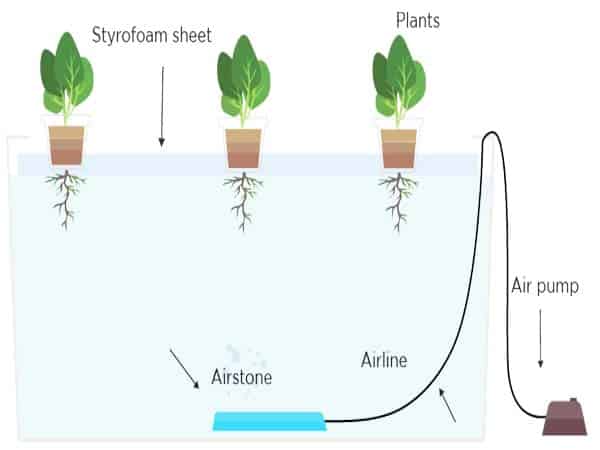
Best-Suited Crops
Ideal for vegetables and herbs such as cucumbers, lettuce, tomatoes, and bok choy.
Advantages
✔ High nutrient efficiency, reducing water waste.
✔ Simple structure, easy to set up and maintain, making it beginner-friendly.
✔ Suitable for small to medium-sized greenhouses and home hydroponic systems.
Disadvantages
✖ Requires strict water quality monitoring, including regular nutrient adjustments.
✖ Oxygen deficiency in summer can lead to root rot, requiring an air pump to improve dissolved oxygen levels.
2. Nutrient Film Technique (NFT)
The Nutrient Film Technique (NFT) has been widely used in countries like the UK since 1975. This system uses a thin layer of flowing nutrient solution (only a few millimeters to 1-2 cm deep), allowing roots to be exposed to air and improving oxygen absorption.
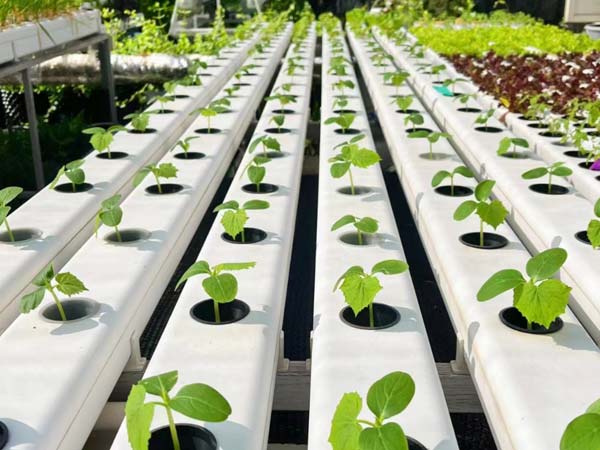
Modern NFT systems consist of growing channels, a nutrient reservoir, a circulation system, and an automated control unit. Many advanced greenhouses use automated nutrient dosing to ensure precise nutrient delivery.
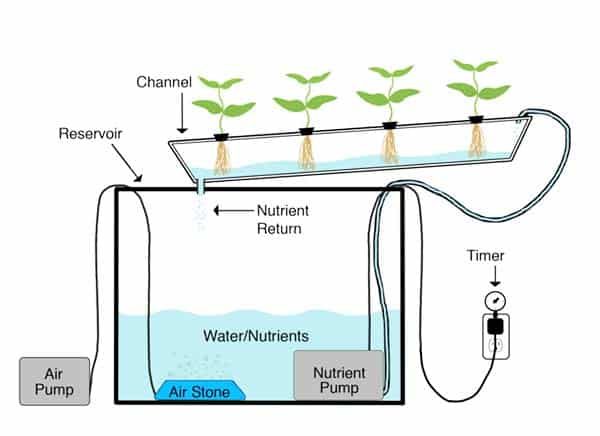
Best-Suited Crops
- Suitable for lettuce, strawberries, bell peppers, tomatoes, and eggplants, especially leafy greens.
- Can also be used for flowers, conifer seedlings, turfgrass, and fodder.
Advantages
✔ Highly water-efficient, recycles nutrients to minimize waste.
✔ Fast-growing leafy greens, making it ideal for large-scale commercial greenhouses.
✔ Vertical growing potential, maximizing space efficiency.
Disadvantages
✖ Relies on a water pump for continuous nutrient flow—if the pump fails, roots can dry out quickly.
✖ Requires precise flow control to prevent root blockages and uneven nutrient distribution.
3. Floating Capillary Hydroponics (FCH)
Floating Capillary Hydroponics (FCH) was developed in 1991 by the Zhejiang Academy of Agricultural Sciences in China as an improved version of NFT. It uses a floating capillary irrigation system to deliver nutrients more effectively.
In an FCH system, a 1.25 cm thick and 14 cm wide polystyrene foam board serves as a floating platform. A 25 cm wide non-woven fabric is placed on top as a wet wick. Plant roots partially grow in the nutrient solution while some extend into the wet wick, absorbing oxygen directly from the air for better aeration.
Best-Suited Crops
Primarily used for leafy greens such as lettuce and spinach.
Advantages
✔ Better oxygen supply than traditional NFT, reducing the risk of root oxygen deficiency.
✔ Energy-efficient, requiring no extra air pumps or circulation pumps.
✔ Even nutrient absorption, easy to manage, and ideal for large-scale production.
Disadvantages
✖ Limited crop variety, unsuitable for fruiting vegetables.
✖ Requires regular wick replacement and prevention of algae growth in nutrient tanks.
4. Aeroponics
Aeroponics is an advanced hydroponic method where nutrient solutions are atomized into fine mist and sprayed directly onto plant roots.
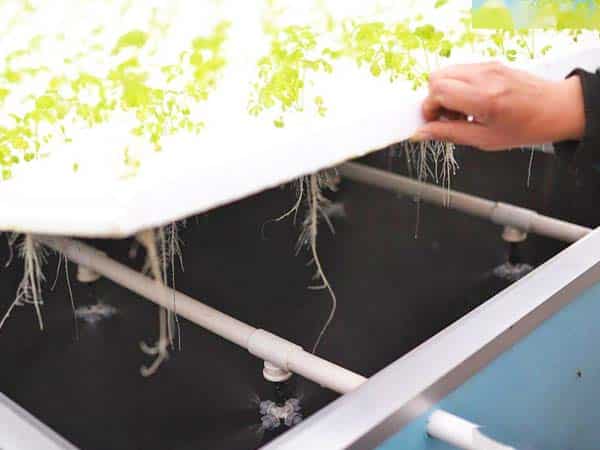
In this system, plant roots hang freely inside a sealed growing chamber where they absorb misted nutrients and maintain high humidity levels. This technique enhances nutrient absorption and optimizes oxygen intake, preventing oxygen deficiency often seen in traditional hydroponic systems.
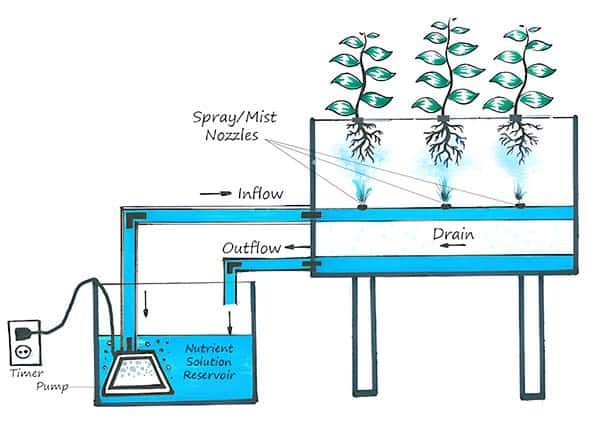
Best-Suited Crops
Suitable for high-value crops like tomatoes, peppers, and strawberries.
Advantages
✔ High nutrient efficiency and fast growth, ideal for high-tech greenhouses.
✔ Automated management and vertical growing, maximizing space and yield.
✔ Minimal water usage, making it an eco-friendly solution.
Disadvantages
✖ High setup costs and maintenance requirements.
✖ Relies on misting systems—if equipment fails or power is lost, roots can dry out quickly.
Types of Aeroponics Systems:
- Full Aeroponics – Roots entirely suspended, relying solely on misted nutrient delivery.
- Semi-Aeroponics – Part of the root system immersed in nutrient solution, while the rest is misted.
B. Substrate-Based Hydroponics Systems
These systems use solid growing media (such as coconut coir, rock wool, or perlite) to anchor plant roots, with nutrients delivered via drip irrigation or ebb-and-flow irrigation.
The key difference between substrate-based hydroponics and strict hydroponics (DWC, NFT, FCH, and aeroponics) is that plant roots are not directly exposed to the nutrient solution. Instead, they absorb nutrients through the growing medium. Since the substrate provides water retention, buffering, and root support, substrate-based systems are better suited for fruiting vegetables like tomatoes, cucumbers, and peppers, making them popular in commercial greenhouses.
5. Drip Hydroponics
Drip hydroponics is one of the most common substrate-based systems. It uses a drip irrigation system to deliver nutrient solutions to the growing medium at scheduled intervals. Plant roots absorb water and nutrients from the medium, while excess solution is either recycled (recirculating system) or discarded (non-recirculating system).
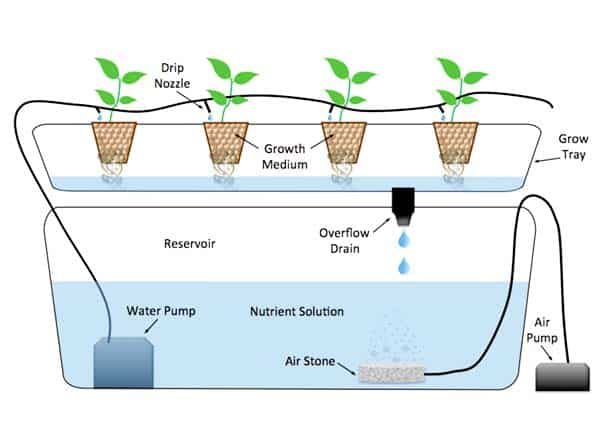
Typical Components
- Growing troughs
- Growing medium (e.g., coconut coir, perlite, rock wool)
- Drip irrigation pipes and emitters
- Nutrient reservoir and circulation pump
Best-Suited Crops
Ideal for large fruiting vegetables such as tomatoes, cucumbers, bell peppers, strawberries, and eggplants.
Advantages
✔ Suitable for large-scale commercial greenhouses, ensuring precise water and nutrient supply.
✔ Ideal for fruiting crops, as the substrate provides strong root support.
✔ Can be automated, reducing labor costs.
Disadvantages
✖ Drip emitters can clog, requiring regular maintenance.
✖ Salt buildup in the substrate, requiring periodic flushing to prevent growth issues.
✖ Non-recirculating systems waste nutrients, while recirculating systems require additional recovery systems.
6. Ebb and Flow (Flood & Drain) System
The ebb and flow system irrigates plants by periodically flooding and draining the substrate bed, mimicking natural tidal cycles. During irrigation, the nutrient solution is pumped into the growing bed, soaking the substrate and roots. Then, during drainage, the solution is emptied, allowing roots to receive fresh oxygen.
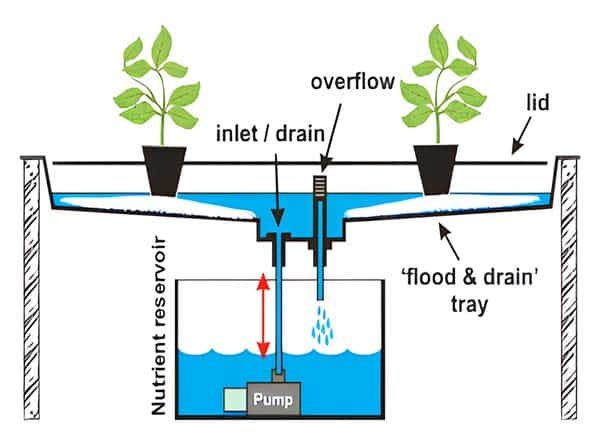
Typical Components
- Growing bed (filled with substrate)
- Nutrient reservoir
- Water pump and control system
Best-Suited Crops
- Suitable for fruiting vegetables such as tomatoes, strawberries, bell peppers, and cucumbers.
- Can also be used for flower cultivation.
Advantages
✔ Improves root oxygenation, while the nutrient flow removes waste gases and old root tissues, reducing disease risks.
✔ Even nutrient distribution, adaptable to various growing media (e.g., coconut coir, rock wool, perlite, expanded clay pellets).
✔ Water- and nutrient-efficient, as the nutrient solution can be recycled.
Disadvantages
✖ Relies on a water pump, so power failures can disrupt irrigation.
✖ More complex maintenance, requiring regular cleaning of pumps and grow beds to prevent algae growth or substrate buildup.
✖ Requires precise water level control, as overflooding can lead to root rot.
7. Wick System
The wick system is one of the simplest substrate-based hydroponic methods. It operates using capillary action, where wick materials (such as cotton ropes or fabric strips) draw nutrient solution from a reservoir into the growing medium. This method does not require pumps or electricity.
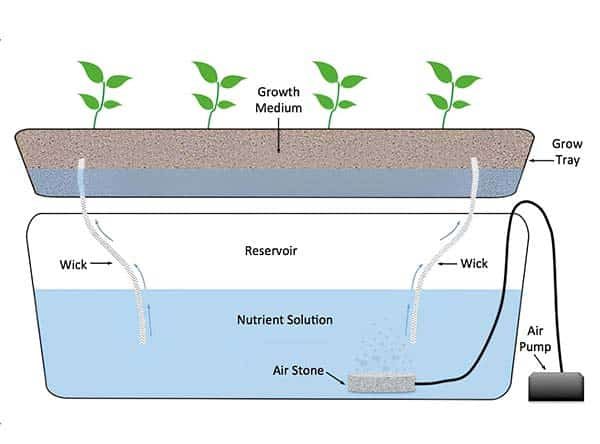
Typical Components
- Growing container (filled with substrate)
- Nutrient reservoir
- Wick (e.g., cotton rope, felt strips)
Best-Suited Crops
Ideal for small plants and herbs such as mint and basil. And for home or school educational projects, but not suitable for commercial production.
Advantages
✔ No electricity required, making it a low-cost solution.
✔ Easy to set up, perfect for home growers and small-scale experiments.
✔ Stable water and nutrient supply, ideal for small plants.
Disadvantages
✖ Low water efficiency, unsuitable for water-demanding crops.
✖ Limited nutrient control, leading to potential over- or under-watering.
✖ Salt buildup in the substrate, requiring regular flushing or substrate replacement.
Which Hydroponic System Is Best for Your Greenhouse?
When choosing the right hydroponic system for your greenhouse, growers must consider multiple factors. Therefore, we offer the comparison table below to help you quickly understand the key differences between various hydroponic systems, allowing you to select the best option based on your needs.
| Hydroponic System | Best-Suited Crops | Advantages | Disadvantages | Ideal Scale | Technical Difficulty | Initial Investment | Maintenance Cost |
| DWC (Deep Water Culture) | Leafy greens (lettuce, spinach, bok choy), cucumber, tomato | High nutrient efficiency, water-saving, easy to manage | Requires strict water quality control, needs an air pump for oxygenation | Small to medium greenhouses, home hydroponics | Low | Low | Low |
| NFT (Nutrient Film Technique) | Lettuce, strawberry, bell pepper, tomato, eggplant | Highly water-efficient, ideal for dense planting, fast leafy growth | Depends on a water pump, requires precise flow control | Commercial greenhouses, large-scale production | Medium | Medium | Low |
| FCH (Floating Capillary Hydroponics) | Leafy greens (lettuce, spinach) | Better oxygen supply, great for large-scale production | Limited to specific crops, requires frequent wick replacement | Large-scale greenhouses | Medium | Medium | Low |
| Aeroponics | High-value crops (tomato, pepper, strawberry) | Maximum nutrient efficiency, fast growth, ideal for automation | Expensive equipment, high maintenance | High-tech greenhouses | High | High | High |
| Drip Hydroponics | Tomato, cucumber, bell pepper, strawberry, eggplant | Perfect for commercial greenhouses, precise nutrient control | Drip emitters clog easily, salt buildup in the substrate | Commercial greenhouses | Medium | Medium | Medium |
| Ebb and Flow (Flood & Drain) | Tomato, strawberry, bell pepper, cucumber, flowers | Stable nutrient supply, excellent oxygenation | Pump-dependent, requires frequent cleaning | Small to medium greenhouses | Medium | Medium | Medium |
| Wick System | Small plants, herbs (mint, basil) | No electricity required, low-cost, easy setup | Low efficiency, limited crop choices | Home gardens, educational projects | Low | Low | Low |
Final Thoughts
The best hydroponic system depends on your greenhouse setup, crop requirements, and management capabilities – there is no single perfect solution for everyone. In addition, choosing the right system is just the first step. To maintain a highly productive hydroponic greenhouse, you must focus on precision management, including:
- Monitoring pH and EC levels to maintain an optimal nutrient balance.
- Controlling temperature, humidity, and lighting for stable growth conditions.
- Regularly cleaning pumps, pipes, and drip emitters to prevent clogging and contamination.
- Adjusting water and fertilizer formulas according to plant growth stages for higher yields.
If you’re planning to build a modern, automated hydroponic greenhouse, contact us today for professional consultation and pricing. We can provide you with high-efficiency, smart hydroponic solutions tailored to your needs!
